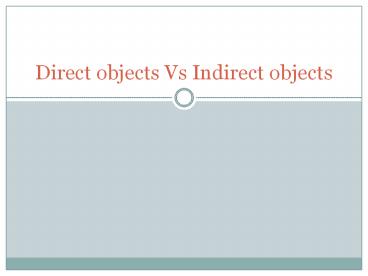Direct objects Vs Indirect objects - PowerPoint PPT Presentation
1 / 17
Title:
Direct objects Vs Indirect objects
Description:
The indirect object is the thing that receives the direct object. IO in Spanish Me ... What Indirect object pronoun ... DO Pronouns IO Pronouns ... – PowerPoint PPT presentation
Number of Views:492
Avg rating:3.0/5.0
Title: Direct objects Vs Indirect objects
1
Direct objects Vs Indirect objects
2
(No Transcript)
3
Direct objects
- Bob throws the ball.
- Who is the subject?
- Bob
- What is the verb? (what is being done?)
- Throw
- What is the direct object?(What is being Thrown?
- The ball
- What pronoun can we use to replace ball?
- It
- Bob throws it.
4
Tirar or echar - to throw
- Bob tira la pelota.
- What direct object pronoun can we use to replace
la pelota? - La
- Do we put the la before or after the verb?
(remember NC PIG?) - Bob la tira.
5
(No Transcript)
6
Indirect objects!!!!
- Bob throws the ball to Jane.
- We know that bob is the subject and throw is the
verb, ball is the direct object so what do you
think the indirect object is? - Jane is the is the indirect object. The indirect
object is the thing that receives the direct
object.
7
IO in Spanish
- Me Me
- Te You (Fam.)
- Le He She It You
(formal) - Nos We
- Les They/ them You all
8
One step at a time
- Bob tira la pelota a Jane.
- What Indirect object pronoun can we use to
replace Jane? - Le
- Bob le tira la pelota.
- Bob se la tira.
9
DO Pronouns IO Pronouns English Equivalent
me me me
te te you (familiar)
lo, la le him, her, it, you (formal)
nos nos us
os os you-all (familiar)
los, las les them, you-all (formal)
10
When you have both a direct object pronoun and an
indirect object pronoun in the same sentence, the
indirect object pronoun comes first. Ellos me
los dan.They give them to me.IO pronoun meDO
pronoun los Ella te la vende.She sells it to
you.IO pronoun teDO pronoun la
11
Whenever both pronouns begin with the letter "l"
change the first pronoun to "se. le lo se
lole la se lale los se losle las se
lasles lo se loles la se lales los se
losles las se las
12
In negative sentences, the negative word comes
directly before the first pronoun. No se lo
tengo.I don't have it for you. Nunca se los
compro.I never buy them for her.
13
Because the pronoun se can have so many meanings,
it is often helpful to clarify it by using a
prepositional phrase. Él se lo
dice.Ambiguous. He tells it to (whom?). Él se lo
dice a Juan.He tells it to him. (to Juan) Él se
lo dice a María.He tells it to her. (to
María) Él se lo dice a ella.He tells it to her.
14
In sentences with two verbs, there are two
options regarding the placement of the pronouns.
Place them immediately before the conjugated verb
or attach them directly to the infinitive. She
should explain it to me. Ella me lo debe
explicar.Ella debe explicármelo. I want to tell
it to you.Te lo quiero decir.Quiero
decírtelo. You need to send it to them.Se la
necesitas enviar a ellos.Necesitas enviársela a
ellos.
Note that when attaching the pronouns to the
infinitive, a written accent is also added to the
final syllable of the infinitive. This preserves
the sound of the infinitive.
15
When the pronouns are attached to the infinitive,
make the sentence negative by placing the
negative word directly before the conjugated
verb. Ella debe explicármelo.Ella no debe
explicármelo. Quiero decírtelo.No quiero
decírtelo. Necesitas enviársela a ellos.No
necesitas enviársela a ellos.
16
When the pronouns come before the conjugated
verb, make the sentence negative by placing the
negative word directly before the pronouns. Ella
me lo debe explicar. Ella no me lo debe
explicar. Te lo quiero decir.No te lo quiero
decir. Se la necesitas enviar a ellos.No se la
necesitas enviar a ellos.
17
(No Transcript)

